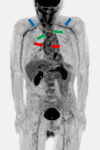[Necrosis of the tongue as a clinical manifestation of giant cell arteritis]
- PMID: 37861722
- PMCID: PMC11058976
- DOI: 10.1007/s00108-023-01607-w
[Necrosis of the tongue as a clinical manifestation of giant cell arteritis]
Abstract
An 83-year-old male patient presented due to a 3-week history of swelling of the tongue with tongue pain on eating, yellowish plaques, and a gray-brown lesion in the anterior portion of the tongue. Sudden loss of vision in the left eye and temporal headache occurred 3 days before presentation. Due to elevated C‑reactive protein, sonography of the supraaortic arteries as well as positron emission tomography/computed tomography was performed. Imaging revealed inflammation of the great arteries as well as a halo sign on ultrasound of the temporal artery. Thus, a diagnosis of giant cell arteritis with necrosis of the tongue was made. Immunosuppressive therapy with glucocorticoids was initiated. Necrosis of the tongue is a rare manifestation of giant cell arteritis that requires immediate immunosuppressive therapy to prevent further complications to the tongue (e.g., complete necrosis of the tongue, superinfection, tongue amputation).
Ein 83-jähriger Patient stellte sich aufgrund einer seit drei Wochen bestehenden Schwellung der Zunge vor. Die Zungenschwellung ging mit Schmerzen beim Essen, gelblichen Plaques sowie einer gräulich-braunen Läsion im vorderen Abschnitt der Zunge einher. Zusätzlich waren ein plötzlicher Sehverlust auf dem linken Auge und temporale Kopfschmerzen seit drei Tagen zu verzeichnen. Aufgrund eines paraklinisch erhöhten C‑reaktiven Proteins und der bestehenden Symptomatik wurden eine Sonographie der supraaortalen Arterien und auch eine Positronenemissionstomographie/Computertomographie durchgeführt. Es zeigten sich in der Bildgebung eine Entzündung der großen Arterien sowie ein Halophänomen in der Sonographie der A. temporalis. Somit konnte die Diagnose einer Riesenzellarteriitis mit Zungennekrose gestellt werden. Eine immunsuppressive Therapie mit Glukokortikoiden wurde eingeleitet. Die Zungennekrose stellt eine seltene Manifestation einer Riesenzellarteriitis dar, welche einer umgehenden immunsuppressiven Therapie bedarf, um weitere Folgeschäden, wie vollständige Nekrose und Superinfektion bis zur Zungenamputation, zu vermeiden.
Keywords: Corticosteroids; Giant cell arteritis; Positron emission tomography/computed tomography; Tongue necrosis; Ultrasound.
© 2023. The Author(s).
Similar articles
-
Tongue necrosis as first symptom of giant cell arteritis (GCA).Clin Rheumatol. 2009 Jun;28 Suppl 1:S47-9. doi: 10.1007/s10067-009-1141-z. Epub 2009 Mar 10. Clin Rheumatol. 2009. PMID: 19277817
-
Tongue necrosis in a patient with cranial arteritis.Braz J Otorhinolaryngol. 2007 Sep-Oct;73(5):717. doi: 10.1016/s1808-8694(15)30135-x. Braz J Otorhinolaryngol. 2007. PMID: 18094816 Free PMC article. No abstract available.
-
Tongue necrosis secondary to giant cell arteritis.BMJ Case Rep. 2023 May 16;16(5):e254888. doi: 10.1136/bcr-2023-254888. BMJ Case Rep. 2023. PMID: 37192780 Free PMC article.
-
Tongue necrosis as a complication of temporal arteritis.Oral Surg Oral Med Oral Pathol. 1994 Oct;78(4):448-51. doi: 10.1016/0030-4220(94)90036-1. Oral Surg Oral Med Oral Pathol. 1994. PMID: 7800375 Review.
-
[Horton's disease diagnosed in partial necrosis of the tongue].Ann Dermatol Venereol. 1987;114(8):983-6. Ann Dermatol Venereol. 1987. PMID: 3322147 Review. French. No abstract available.
References
-
- Malich L, Gühne F, Hoffmann T, Malich A, Weise T, Oelzner P, Wolf G, Freesmeyer M, Pfeil A. Distribution patterns of arterial affection and the influence of glucocorticoids on (18)F-fluorodeoxyglucose positron emission tomography/CT in patients with giant cell arteritis. RMD Open. 2022;8(2):e002464. doi: 10.1136/rmdopen-2022-002464. - DOI - PMC - PubMed
Publication types
MeSH terms
Substances
LinkOut - more resources
Full Text Sources
Medical
Research Materials



